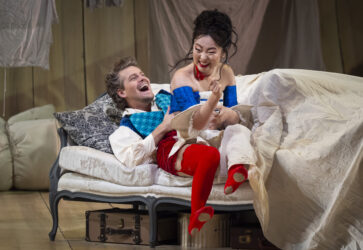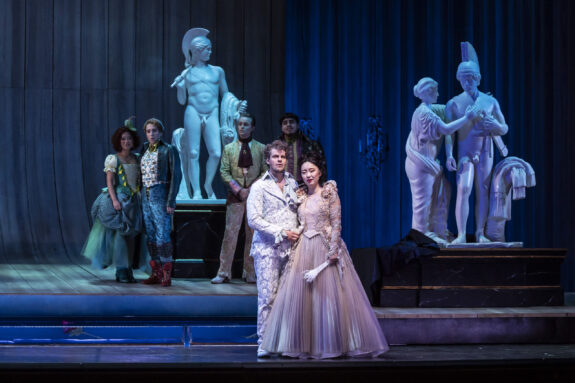 United States Mozart, Le nozze di Figaro: Soloists, Chorus and Orchestra of Lyric Opera of Chicago / Erina Yashima (conductor). Civic Opera House, Chicago, 9.11.2024. (JLZ)
United States Mozart, Le nozze di Figaro: Soloists, Chorus and Orchestra of Lyric Opera of Chicago / Erina Yashima (conductor). Civic Opera House, Chicago, 9.11.2024. (JLZ)

For Johannes Brahms, a performance of Mozart’s The Marriage of Figaro made an ordinary day a festival, and its return to Lyric Opera of Chicago after a decade-long absence is also a cause for celebration. Barbara Gaines’s 2015–2016 production uses some conventions of eighteenth-century staging in a twenty-first century milieu and, even though the revival has much to recommend it, the execution had some problems. Props were left on stage for the stagehands to remove, most egregiously the chairs at the end Act III. In addition, the house lights went off when the bows ended, and it was difficult to exit safely in partial darkness.
On another level, the supertitles were distracting It was good to see a vivid translation, but the colloquialisms in the translation included poor word choices, with some idioms being more bawdy than humorous. That stated, I have heard the aria ‘Porgi amor’ in Act II sung mediocrely, well and even sublimely, but I have never heard it performed with the audience breaking into guffaws at this revelatory moment in the score. It should have been no surprise when a person seated nearby used her phone flashlight throughout that number and let it ring near the aria’s end to receive a call. While this is a case in extremis, the tone of the supertitles raised questions.
Another issue concerns the volume. Kayleigh Decker as Cherubino was positioned in such a way in Act I that she sounded as if she were singing sotto voce. Decker was more audible in Act II which included a solid reading of ‘Voi che sapete’, but it was easier to hear her in the ensembles, particularly those that included Federica Lombardi as the Countess. Lombardi’s opening lines suffered from positioning on an oversized bed mid-stage, and the result was a distant, tentative sound that was obscured by laughter when the translation appeared. Her interactions with Ying Fang as Susannah had better balances which allowed their clear diction and precise intonation to emerge. As for Lombardi, one of the outstanding moments was her interpretation of ‘Dove sono’ in Act III.
Ying Fang was captivating as Susannah, a role she has played at other houses. Her tone and pacing made the first-act duet with Sarah Mesko as Marcellina (‘Via resti servita, madama brillante’) captivating, and the entrances intersected with musical and dramatic precision. It was similar in the well-known letter duet of Act III (‘Sull’aria’), where Ying Fang worked intently with Lombardi to make the duet stand out, just as it had in their performances of the work at the Met during the 2021–2022 season. ‘Deh vieni non tardar’ in the final act was exquisite for the pure tone and subtle phrasing that Ying Fang gave this crucial moment in the opera as she paced the phrasing to offer a reflective moment in this sometimes-frantic production. Even though some of the audience applauded before the final phrase, Fang commanded the stage and received an appropriately strong response at the conclusion.

As for the other principals, Peter Kellner brought good humor to his portrayal of Figaro. He gave full voice to his part and was particularly strong in ‘Non più andrai’. At times his interpretation of Figaro was reminiscent of Papageno, another role that suits his abilities. Gordon Bintner was a lecherous and sometimes brooding Count Almaviva, and ‘Vedrò, mentr’io sospiro’ in Act III was an opportunity to hear his resonant voice on its own. Sarah Mesko was convincing as Marcellina and worked well with Nicholas Newton’s Bartolo, who established his character in the aria ‘La vendetta, oh la vendetta!’ The full-bodied vehemence set up the mechanism for plot elements that would delay the wedding.
While the chorus, led by Michael Black, was always reliable, the orchestra was uneven. At times the sonorities were unbalanced. It was not a matter of loud versus soft but of voicings that deserved refinement. At one point in the Act II finale, the low strings’ resonance suggested an organ pedal in overbalancing the ensemble. Since this was the first show of the run, these details could be resolved in later performances.
Taken as a whole, the production returned a fine staging to Lyric Opera of Chicago. More than that, the performances are dedicated to the memory of Sir Andrew Davis, the house’s late musical director and principal conductor, and that gesture itself reminds one of the contributions the Maestro made in enhancing the level at Lyric from 2000 to 2021. To respect the contributions of Sir Andrew Davis, Lyric Opera of Chicago may consider a new production of Le nozze di Figaro that will bring this perennially popular opera here more frequently.
James L. Zychowicz
Production:
Director – Barbara Gaines
Sets – James Noone
Costumes – Susan Mickey
Lighting – Robert Wierzel
Choreographer – Harrison McEldowney
Fight director – Chuck Coyl
Chorus director – Michael Black
Cast:
Figaro – Peter Kellner
Susanna – Ying Fang
Dr Bartolo – Nicholas Newton
Marcellina – Sarah Mesko
Cherubino – Kayleigh Decker
Count Almaviva – Gordon Bintner
Don Basilio – Brenton Ryan
Countess Almaviva – Federica Lombardi
Antonio – Matt Boehler
Don Curzio – Daniel Espinal
Barbarina – Gemma Nha
Peasant Girls – Emily Richter and Lucy Baker
